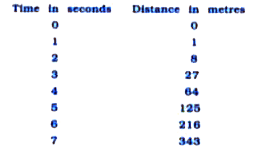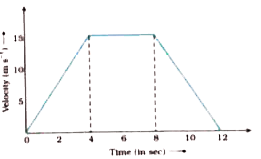Which would require a greater force-accelerating a 2kg mass at 5 m s−2 or a 4kg mass at 2 ms−2?Solution in Gujrati
Here, F=ma
m1=2kg,a1=5ms−2 and
m2=4kg,a2=2ms−2
This,F−(1)=m1a1=2kg×5ms−2=10 N and
F2=m2a2=4kg×2ms−2=8N
⇒F1F2
Thus accelerating a 2 kg mass at 5 ms−2
Would require a greate force.
Topper's Solved these Questions
- BOOK - KUMAR PRAKASHANCHAPTER - FORCE AND LAWS OF MOTIONEXERCISE - Additional solved numericals9videos
FORCE AND LAWS OF MOTION
- BOOK - KUMAR PRAKASHANCHAPTER - FORCE AND LAWS OF MOTIONEXERCISE - Additional Exercise4videos
FORCE AND LAWS OF MOTION
- BOOK - KUMAR PRAKASHANCHAPTER - FORCE AND LAWS OF MOTIONEXERCISE - QUESTIONS AND ANSWERS(Answer the following questions in detail:)4videos
FORCE AND LAWS OF MOTION
- BOOK - KUMAR PRAKASHANCHAPTER - GRAVITATIONEXERCISE - ACTIVITY 10.42videos
GRAVITATION
Similar Questions
A truck starts from rest and rolls down a hill with a constant acceleration .It travels a distance of 400 m in 20 ms.Find its acceleration 6 tones (Hint:1 tonne =1000 kg)
03:11View SolutionThe following is the distance-time table of an object in motion:

(a)What conclusion can you draw about the acceleration ?Is it constant. Increasing decreasing ir zero? (b)What do you infer about the force acting on the object?02:24View Solution(a)Define :Force
(b)The velocity -time graph of a car of mass 1000 kg is given below:
(i)When is the maximum force acting on the car>Why?
(ii)What is the retarding force?02:53View SolutionTake an empty plastic bottle . Close the mouth of the bottle with an airtight stopper . Put it in a bucket filled with watere . The bottle floats .
Push the bottle into the water. You feel an upward push. Try to push it further down. You will find it difficult to push deeper and deeper. Water exerts a force on the bottle in upward direction. Now release the bottle. It bounces back to the surface.
Does the force due to the gravitational attraction of the earth act on this bottle? If so, why doesn't the bottle stay immersed in water after it is released ?01:15View SolutionA force of 5N gives a mass m1, an acceleration of m/s2, and a mass m2, an acceleration of 24m/s2. What acceleration would it give if both the masses are tied together?
02:36View SolutionWhich would requires a greater force: accelerating a 2kg mass at 5m/s2 or a 4kg mass at 2m/s2?
04:13View SolutionWhich would require a greater force - accelerating a 10 g mass at 5 m/ s^(2) or 20 g mass at 2 m/ s^(2) ?
02:38View Solutionनिम्न में से किस पर अधिक बल की आवश्यकता होगी ?
(i) 2 किग्रा द्रव्यमान की वस्तु का त्वरण 5 मीटर/सेकण्ड 2 या
(ii) 4 किग्रा द्रव्यमान की वस्तु का त्वरण 2 मीटर/सेकण्ड 204:35View Solutionकिसमें अधिक बल की आवश्यकता होगी : 2 kg द्रव्यमान वाली किसी वस्तु में 5m/s2 का त्वरण उत्पन्न करने में या 4 kg द्रव्यमान वाली वस्तु में 2m/s2 का त्वरण उत्पन्न करने में ?
01:18View Solutionकिसी द्रव्यमान m1 पर 5 N का बल लगाने पर 8m/s2 का त्वरण उत्पन्न होता है जबकि इसी परिमाण का बल द्रव्यमान m2 में 24m/s2 का त्वरण उत्पन्न करता है। यदि दोनों द्रव्यमान को परस्पर बाँधकर एक कर दिया जाए, तो इस बल द्वारा संयुक्त द्रव्यमान में कितना त्वरण उत्पन्न होगा ?
03:02View Solutionयदि 2 kg द्रव्यमान की किसी वस्तु A में 5m/s2 का त्वरण उत्पन्न करने के लिए F1 बल की आवश्यकता होती है और 4 kg द्रव्यमान की दूसरी वस्तु B में 2m/s2 का त्वरण उत्पन्न करने के लिए F2 बल की आवश्यकता होती है, तो निम्नलिखित में कौन सही है?
01:47View SolutionA force of 5 N gives a mass m_(1) an acceleration of 8m//s^(2) and a mass m_(2) an accleration of 24 m//s^(2) . What acceleration would it give if both the masses are tied together?
01:21View Solutionएक 5 किग्रा द्रव्यमान की वस्तु में 4m/s2 का त्वरण उत्पन्न करने के लिए कितने बल की आवश्यकता होगी?
01:56View SolutionWhich would requires a greater force: accelerating a 2kg mass at 5m/s2 or a 4kg mass at 2m/s2?
03:04View Solution1kg द्रव्यमान वाली वस्तु को 10m/s2 की दर से त्वरित करने में कितना बल की आवश्यकता होगी?
02:24View Solution

